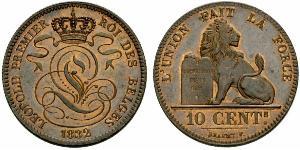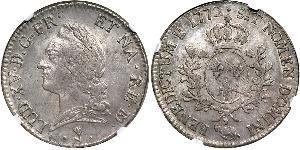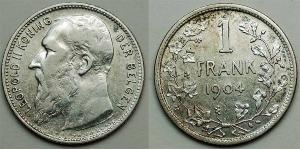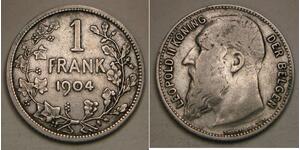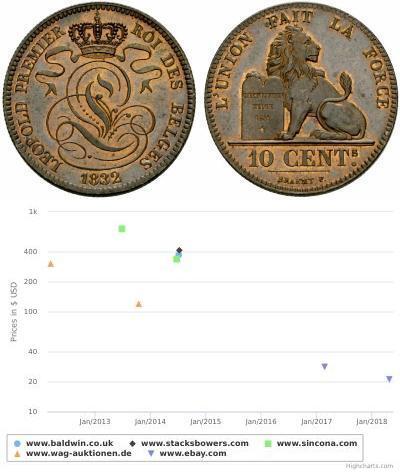1 Ecu (售价 $810.0)
1394, Royal France, Charles VI. Beautiful Gold "Ecu" Coin. Rare!
Mint Place: Paris
Mint year: 1394 (29th July 1394)
References: Duplessy 369, Friedberg 291. R!
Condition: A few tiny marks, otherwise a nice XF!
Ruler (King) : Charles VI le Bien-Aimé/le Fol ("the Well-Beloved/the Mad")
Denomination: Écu d’or à la couronne ("Gold Ecu with Crown") 1st Emission
Diameter: 29.3mm
Weight: 3.63gm
Material: Gold!
Obverse: Crowned shield with three lis inside (Royal arms of France).
Legend: + KAROLVS xx DEI xx GRACIA xx FRAnCORVm xx REX
Reverse: Cross fleurée, lis in alternating quarters and star at center. All within quatrelobe. Four crowns in angles.
Legend: + XPC * VINCIT * XPC * REGANT * XPC * IMPERAT.
Plagued by a disease now believed to be schizophrenia, Charles VI received his nickname le Fol (the Mad) on account of many bouts of madness, the first of which affected him in his early 20’s. As this affliction grew more severe, power slowly shifted back to those who held a great deal of power during Charles’s regency – his uncles, Philippe and Jean, the dukes of Bourgogne and Berry, respectively. Joining this power struggle was Louis I, the duke of Orléans. With this conflict raging, Henry V of England led an invasion into France culminating with the Battle of Agincourt in 1415 and, five years later, Charles signed the Treaty of Troyes, naming Henry as his sole heir, disinheriting his son, the dauphin (later Charles VII), and marrying his daughter to Henry; she bore him a son – Henry VI, the only English king to be de facto king of France until he was driven out by his uncle, the disinherited Charles.
Charles VI (b. 3 December 1368 – d. 21 October 1422), called the Well-loved (French: le Bien-Aimé) and the Mad (French: le Fol or le Fou), was the King of France from 1380 to 1422, as a member of the House of Valois.
He was born in Paris, the son of King Charles V and Jeanne de Bourbon. At the age of eleven, he was crowned King of France in 1380 in the cathedral at Reims. He married Isabeau of Bavaria in 1385. Until he took complete charge as king in 1388, France was ruled primarily by his uncle, Philip the Bold, Duke of Burgundy.
Charles VI was known both as Charles the Well-loved and later as Charles the Mad, since, beginning in his mid-twenties, he experienced bouts of psychosis. These fits of madness would recur for the rest of his life. Based on his symptoms, he probably suffered from schizophrenia.
Charles VI's reign was marked by the continuing conflict with the English known as the Hundred Years' War. An early attempt at peace occurred in 1396 when Charles's daughter, the almost seven-year-old Isabella of Valois, married the 29-year-old Richard II of England.
By 1415, however, the feud between the Royal family and the house of Burgundy had led to chaos and anarchy throughout France. Taking advantage, Henry V of England led an invasion which culminated in October when the French army was defeated at the Battle of Agincourt.
With the English taking over the country, John the Fearless sought to end the feud with the Royal family by negotiating with the Dauphin, the King's heir. They met at the bridge at Montereau on 10th of September 1419 but during the meeting, the Duke was killed by Tanneguy du Châtel, a follower of the Dauphin. John's successor, Philip the Good, threw in his lot with the English.
(Philip the Good would later make peace with the Dauphin, now Charles VII, with the Treaty of Arras when, under the inspiration of Joan of Arc, the tide of the war turned in favour of the French. Joan was burned at the stake when Burgundy handed her over to the English.)
In 1420, King Charles signed the Treaty of Troyes which recognized Henry of England as his successor, disinherited his son, the Dauphin Charles, and betrothed his daughter, Catherine of Valois, to Henry (see English Kings of France).
Many historians have misinterpreted this treaty and the disinheriting of the Dauphin Charles. The Dauphin sealed his fate, in the eyes of the king, by committing treason: he declared himself regent, usurping royal authority, and refused to obey the king's order to return to Paris. It is important to remember that when the Treaty of Troyes was finalized in May 1420, the Dauphin Charles was only 17 years old. He was a weak figure who was easily manipulated by his advisors and even his own mother despised him.
Charles VI died in 1422 at Paris and is interred with his wife Isabeau de Bavière in Saint Denis Basilica. Both their grandson, the one-year-old Henry VI of England, and their son, Charles VII, were proclaimed King of France, but it was the latter who became the actual ruler with the support of Joan of Arc.
Charles VI appears to have passed on his mental illness to his grandson Henry, whose inability to govern led England to a civil strife of its own known as the Wars of the Roses.

|
发布人:
anonymous 2014-10-27 |
|
||
|
||
|
||
|
||
|
||
211 coins were grouped from 2025-05-21 to 2025-05-28
其中一个是:
1 Franc 比利时 銀 利奥波德二世 (比利时)
本组有 15 钱币 / 14 售价
⇑

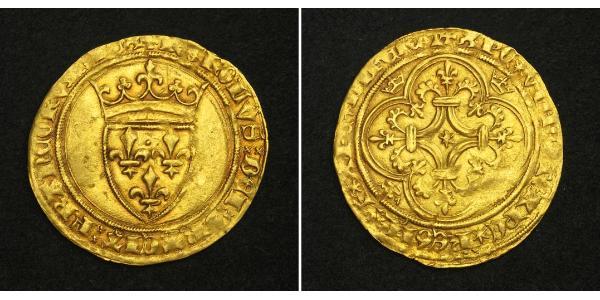

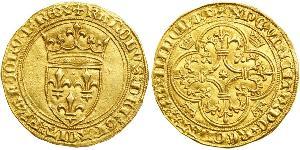
 Deutsch
Deutsch Русский
Русский Українська
Українська English
English Italiano
Italiano Français
Français Español
Español 汉语
汉语


